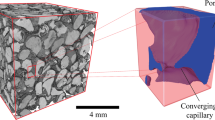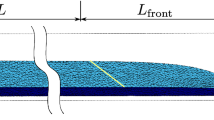Abstract
This article reports the experimental results of a study of the wetting-front microscale structure formed only by capillary forces in homogeneous and random etched glass capillary models. In the homogeneous model, water propagates through the capillary system, evenly filling the capillaries across the direction of flow. Air is trapped by the pinch-off mechanism inside the pore bodies in the form of individual bubbles. The experiments specified three consecutive steps of the pinch-off mechanism, ‘film flow’, ‘snap-off’, and ‘interface movement’. In the random model, both the bypass and pinch-off, forming ‘bypass/cut-off’ mechanism, create residual air structure. Bypass traps air inside large capillary-pore aggregates which are bounded by small-diameter capillaries in where pinch-off traps air in the adjacent pores. An analysis of the residual air distribution versus depth below the surface in the homogeneous and random micromodels made it possible to identify three successive zones, namely a transition zone, a transmission zone, and a wetting-and-front zone. In the transition zone, the residual air content increases with depth from zero to the constant value in the transmission zone where it remains practically constant. The capillary processes within the wetting-and-front combined zone govern air replacement with wetting and formation of the transmission zone.
Similar content being viewed by others
References
Baker, R. S. and Hillel, D.: 1990, Laboratory test of a theory of fingering during infiltration into layered soils, Soil Sci. Soc. Am. J. 54, 20-30.
Bodman, G. B. and Colman, E. A.: 1943, Moisture and energy conditions during downward entry of water into soils, Soil Sci. Soc. Am. Proc. 8, 116-122.
Diment, G. A., Watson, K. K. and Blennerhassett, P. J.: 1982, Stability analysis of water movement in unsaturated porous materials. 1. Theoretical consideration, Water Resour. Res. 19, 1002-1010.
Diment, G. A. and Watson, K. K.: 1983, Stability analysis of water movement in unsaturated porous materials. 2. Numerical studies, Water Resour. Res. 18, 1248-1254.
Diment, G. A. and Watson, K. K.: 1985, Stability analysis of water movement in unsaturated porous materials. 3. Experimental studies, Water Resour. Res. 21, 979-984.
Gardner, W. R.: 1958, Some steady-state solutions of unsaturated moisture flow equations with application to evaporation from a water table, Soil Sci. 85(4), 228-232.
Gardner, W. R. and Hsieh, J. C.: 1959, Water movement in soil, report, Dept. of Agron., Wash. State Univ., Pullman.
Glass, R. J., Steenhuis, T. S. and Parlange, J. Y.: 1989, Wetting front instability. 2. Experimental determination of relationships between system parameters and two-dimensional unstable flow field behavior in initially dry porous media, Water Resour. Res. 25(6), 1195-1207.
Gvirtzman, H., Margaritz, M., Klein, E. and Nadler, A.: 1987, A scanning electron microscopy study of water in soil, Transport in Porous Media 2, 83-93.
Hammond, P. S.: 1983, Nonlinear adjustment of a thin annular film of viscous fluid surrounding a thread of another within a circular cylindrical pipe, J. Fluid Mech. 137, 363-384.
Hill, D. E. and Parlange, J. Y.: 1972, Wetting front instability in layered soils, Soil Sci. Soc. Am. Proc. 36, 697-702.
Hillel, D.: 1987, Unstable flow in layered soils: A review, Hydrol. Proc. 1, 143-147.
Hillel, D. and Baker, R. S.: 1988, A descriptive theory of fingering during infiltration into layered soil, Soil Sci. 146, 51-56.
Holmes, J. W. and Colville, J. S.: 1970, Forest hydrology in a karstic region of southern Australia, J. Hydrol. 10, 59-74.
Lenormand, R.: 1990, Liquids in porous media, J Physics: Condens. Matter 2, SA79-SA88.
Lenormand, R. and Zarcone, C.: 1984, Role of roughness and edges during imhibition in square capillaries, paper 13264, Proc. Soc. Petr. Engng., SPE 59th Ann. Tech. Conf. and Exhibition, Houston.
Lenormand, R., Zarcone, C. and Sarr, A.: 1983, Mechanisms of the displacement of one fluid by another in a network capillary ducts, J. Fluid Mech. 135, 337-353.
Li, Yu. and Wardlaw, N. C.: 1986a, The influence of wettability and critical pore-throat size ration on snap-off, J. Colloid Interface Sci. 109(2), 461-472.
Li, Yu. and N.C. Wardlaw, 1986b, Mechanisms of nonwetting phase trapping during imbibition at slow rates, J. Colloid Interface Sci. 109(2), 473-486.
Lu, T. X., Biggar, J. W. and Nielsen, D. R.: 1994, Water movement in glass bead porous media 2. Experiments of infiltration and finger flow, Water Resour. Res. 30(12), 3283-3290.
Philip, J. R.: 1975, The growth of disturbances in unstable infiltration flows, Soil Sci. Soc. Am. Proc. 39, 1049-1053.
Raats, P. A. C.: 1973, Unstable wetting fronts in uniform and non-uniform soils, Soil Sci. Soc. Am. Proc. 36, 681-685.
Saffman, P. G. and Taylor, G. I.: 1958, The penetration of a fluid into a porous media or Hele-Shaw cell containing a more viscous liquid, Proc. Roy. Soc. A 242, 312-320.
Selker, J. S., Leclerg, P., Parlange, J.-Y. and Steenhuis, T. S.: 1992, Fingered flow in two dimensions 2, Predicting finger moisture profile, Water Resour. Res. 28(9), 2523-2528.
Tamai, N., Asaeda, T. and Jeevaraj, C. G.: 1987, Fingering in two-dimensional, homogeneous, unsaturated porous media, Soil Sci. 144, 107-112.
Van Ommeni, H. C., Dijksmai, R., Hendrickx, J. M. H., Dekker, L. W., Hulshof, J. and Van den Heuv, M.: 1989, Experimental assessment of preferential flow path in a fluid soil, J. Hydrol. 1, 253-262.
Vizika, O. and Payatakes, A. C.: 1989, Parametric experimental study of forced imhibition in porous media, PCH Physicochem. Hydrodynam. 11(2), 187-204.
Weir, G. J. and Kissling, W. M.: 1992, The influence of airflow on the vertical infiltration of water into soil, Water Resour. Res. 28(10), 2765-2772.
White, I. P., Colombera, P.M. and Philip, J. R.: 1997, Experimental studies of wetting front instability induced by gradual changes of pressure gradient and by heterogeneous porous media, Soil Sci. Soc. Am. Proc. 41, 483-489.
White, I. P., Colombera, P. M. and Philip, J. R.: 1976, Experimental studies of wetting front instability induced by sudden changes of pressure gradient, Soil Sci. Soc. Am. Proc. 40, 824-829.
Author information
Authors and Affiliations
Rights and permissions
About this article
Cite this article
Bernadiner, M.G. A Capillary Microstructure of the Wetting Front. Transport in Porous Media 30, 251–265 (1998). https://doi.org/10.1023/A:1006571720867
Issue Date:
DOI: https://doi.org/10.1023/A:1006571720867




